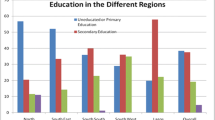Abstract—
The article presents an empirical study of the cross-impact of socioeconomic development in Russian regions and migration in Russia. The employed data include state statistics, sample surveys, and administrative statistics for 2017. It is shown that none of the migration types (long-term international and domestic, international and domestic labor migration) has a statistically significant effect on the indicators of socioeconomic development in Russian regions. At the same time, labor migration, both international and domestic, is most dependent on the integrated development of regions, in contrast to long-term types of migration.
Similar content being viewed by others
Notes
The study was carried out as part of the research work of the state assignment of the RANEPA.
Household Budget Survey.
Labor Force Survey.
GRP per capita, investment in fixed assets per capita, retail turnover per capita, per capita cash income, average monthly wage.
The qualitative assessment of the strength of the relationship was determined on the Chaddock scale: the correlation coefficient from 0 to 0.3 the relationship is very weak, from 0.3 to 0.5 weak, from 0.5 to 0.7 average, from 0.7 to 0.9 high, from 0.9 to 1 very high.
Detailed regression analysis results are available from the authors on request.
REFERENCES
A. G. Korovkin, “Employment and labor market dynamics in the Russian Federation until 2030,” Stud. Russ. Econ. Dev. 24, 353–365 (2013).
L. Yap, “Internal migration and economic development in Brazil,” Q. J. Econ. 90 (1), 119–137 (1976).
M. Levy and W. Wadycki, “A comparison of young and middle aged migration in Venezuela,” Ann. Reg. Sci. 6 (2), 73–85 (1972).
M. Greenwood, “A regression analysis of migration to urban areas of a less-developed country: The case of India,” J. Reg. Sci. 11 (2), 253–262 (1971).
Chan Kam Wing, “Recent migration in China: Patterns, trends, and policies,” Asian Perspect. 25 (4), 127–155 (2001).
The Chinese Economy: Controlling Inflation, Deepening Reform (World Bank, Washington, D.C., 1996).
F. A. Lees, China Superpower: Requisites for High Growth (St. Martin’s Press, New York, 1997).
Cai Fang and Wang Dewen, “The sustainability of China’s economic growth and labor contribution,” J. Econ. Res. 10, 62–68 (1997).
Y. Liu and J. Shen, “Spatial patterns and determinants of skilled internal migration in China, 2000–2005,” Pap. Reg. Sci. 93 (4), 749–771 (2014).
P. L. Martin and J. E. Taylor, “The anatomy of a migration hump,” in Development Strategy, Employment, and Migration: Insights from Models, Ed. by J. E. Taylor (OECD, Development Centre, Paris, 1996), pp. 43–62.
R. J. Barro and X. Sala-i-Martin, “Regional growth and migration: A Japan–United States comparision,” J. Jpn. Int. Econ. 6 (4), 312–346 (1992).
I. Etzo, Internal Migration and Growth in Italy. MPRA Paper (University Library of Munich, 2008).
A. Niebuhr, N. Granato, A. Haas, and S. Hamann, “Does labour mobility reduce disparities between regional labour markets in Germany?,” in Regional Studies (Taylor & Francis, 2011).
G. Hugo, “Temporary migration and the labour market in Australia,” Aust. Geogr. 37 (2), 211–231 (2006).
M. L. Fonseca, “New waves of immigration to small towns and rural areas in Portugal,” Popul. Space Place 14 (6), 525–535 (2008).
C. Kasimis, “Survival and expansion: Migrants in Greek rural regions,” Population Space Place 14 (6), 511–524 (2008).
G. Hugo, “Care worker migration, Australia and development,” Population Space Place 15 (2), 189–203 (2009).
A. M. Williams, “International migration, uneven regional development and polarization,” Eur. Urban Reg. Stud. 16 (3), 309–322 (2009).
S. Guriev and O. Tsyvinskii, “Immigration is not an economic but a political problem,” Vedomosti, Oct. 22 (2012).
H. de Haas, “Migration, remittances and regional development in Southern Morocco,” Geoforum 37 (4), 565–580 (2006).
M. Manic, “The regional effects of international migration on internal migration decisions of tertiary-educated workers,” Reg. Sci. 98 (2), 1027–1051 (2019).
European Commission. Labour Mobility within the EU—The Impact of Enlargement and the Functioning of the Transitional Arrangements (2011).
O. S. Chudinovskikh, “Accounting for migration in Russia: Causes and consequences of the crisis,” Demoskop Wkly., Nos. 185–186 (2015).
E. S. Vakulenko, “Does population migration lead to interregional convergence in Russia?,” Vestn. Novosib. Gos. Univ. Ekon. Upr., No. 4, 239–264 (2013).
S. Guriev and E. Vakulenko, “Internal migration and interregional convergence in Russia,” SSRN (2013).
A. G. Korovkin, I. N. Dolgova, and E. A. Edinak, “Analysis of the relationship between internal migration and socio-economic differentiation of regions (on the example of the Central Federal District),” in Scientific Proceedings: Institute of Economic Forecasting, Russian Academy of Sciences (MAKS Press, Moscow, 2013), Vol. 11, pp. 71–94 [in Russian].
S. A. Anatol’ev, “Econometric educational: Bootstrap. Basics of bootstrapping,” Kvantil’, No. 3, 1–12 (2007).
Yu. F. Florinskaya, N. V. Mkrtchyan, T. M. Maleva, and M. K. Kirillova, Migration and the Labor Market (Delo, Moscow, 2015) [in Russian].
Author information
Authors and Affiliations
Corresponding author
Additional information
Translated by I. Pertsovskaya
Rights and permissions
About this article
Cite this article
Kartseva, M.A., Mkrtchyan, N.V. & Florinskaya, Y.F. Migration in Russia and Regional Socioeconomic Development: Cross-Impact Analysis. Stud. Russ. Econ. Dev. 31, 421–429 (2020). https://doi.org/10.1134/S1075700720040085
Received:
Revised:
Accepted:
Published:
Issue Date:
DOI: https://doi.org/10.1134/S1075700720040085




